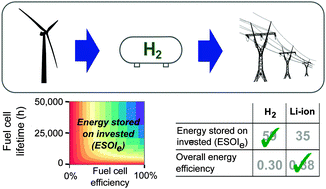Hydrogen or batteries for grid storage? A net energy analysis†
Abstract
Energy storage is a promising approach to address the challenge of intermittent generation from renewables on the electric grid. In this work, we evaluate energy storage with a regenerative hydrogen fuel cell (RHFC) using net energy analysis. We examine the most widely installed RHFC configuration, containing an alkaline water electrolyzer and a PEM fuel cell. To compare RHFC's to other storage technologies, we use two energy return ratios: the electrical energy stored on invested (ESOIe) ratio (the ratio of electrical energy returned by the device over its lifetime to the electrical-equivalent energy required to build the device) and the overall energy efficiency (the ratio of electrical energy returned by the device over its lifetime to total lifetime electrical-equivalent energy input into the system). In our reference scenario, the RHFC system has an ESOIe ratio of 59, more favorable than the best battery technology available today (Li-ion, ESOIe = 35). (In the reference scenario RHFC, the alkaline electrolyzer is 70% efficient and has a stack lifetime of 100 000 h; the PEM fuel cell is 47% efficient and has a stack lifetime of 10 000 h; and the round-trip efficiency is 30%.) The ESOIe ratio of storage in hydrogen exceeds that of batteries because of the low energy cost of the materials required to store compressed hydrogen, and the high energy cost of the materials required to store electric charge in a battery. However, the low round-trip efficiency of a RHFC energy storage system results in very high energy costs during operation, and a much lower overall energy efficiency than lithium ion batteries (0.30 for RHFC, vs. 0.83 for lithium ion batteries). RHFC's represent an attractive investment of manufacturing energy to provide storage. On the other hand, their round-trip efficiency must improve dramatically before they can offer the same overall energy efficiency as batteries, which have round-trip efficiencies of 75–90%. One application of energy storage that illustrates the tradeoff between these different aspects of energy performance is capturing overgeneration (spilled power) for later use during times of peak output from renewables. We quantify the relative energetic benefit of adding different types of energy storage to a renewable generating facility using [EROI]grid. Even with 30% round-trip efficiency, RHFC storage achieves the same [EROI]grid as batteries when storing overgeneration from wind turbines, because its high ESOIe ratio and the high EROI of wind generation offset the low round-trip efficiency.

- This article is part of the themed collection: 2015 most accessed Energy & Environmental Science articles

 Please wait while we load your content...
Please wait while we load your content...